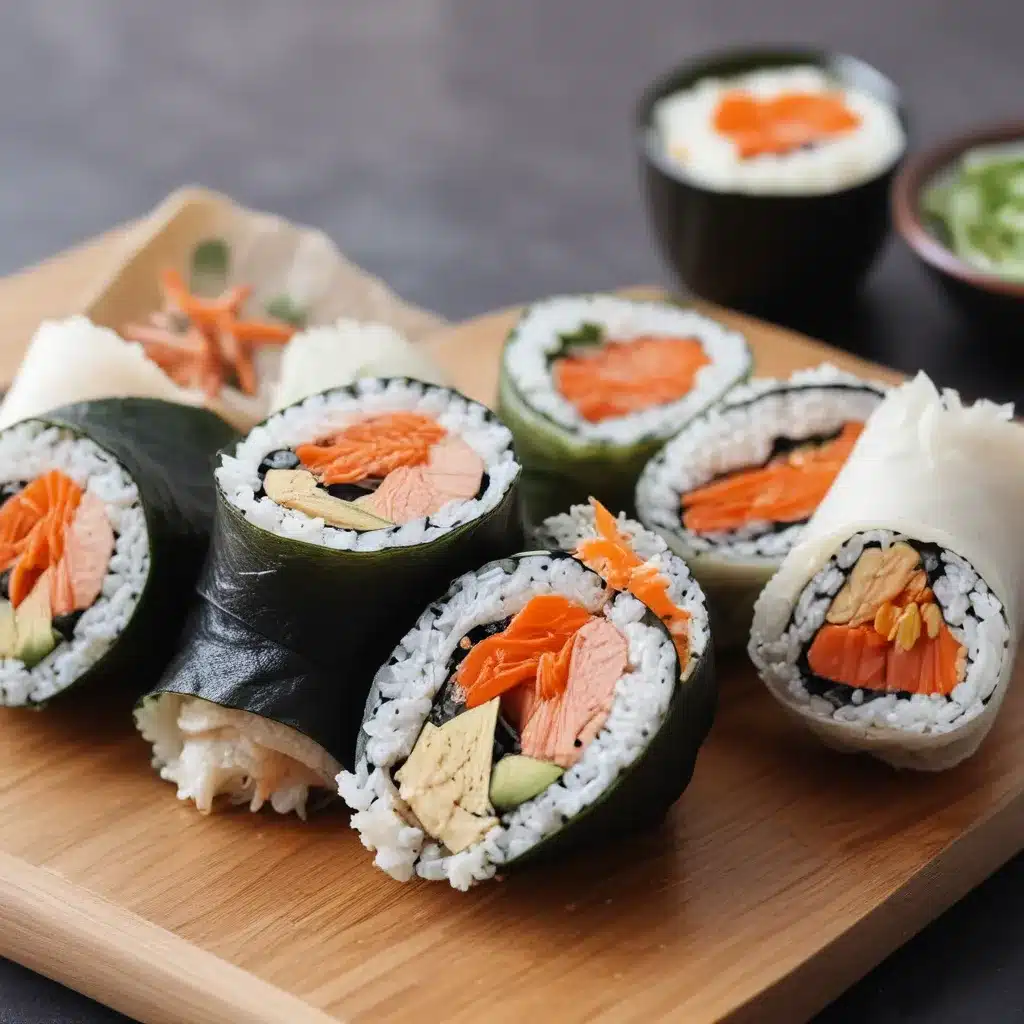
Kimbap: The Korean Sushi Rolls That Stole My Heart
I’ll never forget the day I discovered kimbap. It was a chilly evening, and my husband and I were on our way to a Christmas presentation at our local church. Hungry and in a hurry, we decided to make a quick pitstop at a nearby Korean grocery store. Little did I know, that $3 package of kimbap would change the way I viewed this humble Korean comfort food forever.
Normally, I wouldn’t have given those neatly wrapped kimbap rolls a second thought. They seemed like the quintessential fast food – convenient, inexpensive, and not particularly inspiring. But when I was later challenged to make kimbap for a guest blog spot, I gained a newfound appreciation for the time-honored craft behind these simple, yet delectable Korean hand rolls. [1]
The Art of Kimbap: Mastering the Roll
As I soon learned, the ladies at the Korean market make kimbap assembly look effortless. But that’s because they’ve had years of practice, and the luxury of pre-prepped ingredients at their fingertips. For the rest of us, a little prep work is required to ensure a smooth kimbap rolling experience.
The key is to have all your fillings ready to go before you even think about grabbing that bamboo mat. First, you’ll need to marinate and cook some ground beef. Then, julienne a large carrot and sauté it in olive oil and salt. Don’t forget the bright yellow pickled radish, or “danmuji” – it’s the heart and soul of traditional kimbap. [1]
Next, make a simple egg omelet and slice it into thin strips. And for a time-saving shortcut, grab a bag of ready-to-use spinach, blanch it quickly, and season it with sesame oil and salt. [1]
The final component is the rice. Make sure it’s freshly cooked, but cooled enough to handle. Season it with sesame oil, olive oil, salt, and roasted sesame seeds. [1]
With all your ingredients prepped and ready, it’s time to assemble. Lay a sheet of dried laver seaweed on your bamboo mat, shiny side down. Spread a thin, even layer of rice across the bottom two-thirds of the sheet. Then, add your fillings – danmuji, egg, beef, carrots, and spinach – in neat rows, leaving a gap between each element. [1]
The Roll: Tight and Tidy
Starting from the bottom, begin rolling the seaweed sheet, using the bamboo mat to guide you. The first roll should land right where the excess rice is, helping the kimbap stick together. Gently but firmly, continue rolling and squeezing the mat to ensure a tight, compact roll.
Once your kimbap is fully wrapped, use a brush or your gloved hand to give the surface a light coating of sesame oil. This not only adds flavor, but also helps maintain that beautiful, glistening finish. [1]
Finally, grab a sharp knife and slice the kimbap into thin, bite-sized pieces. Kimbap is traditionally sliced thinner than Japanese maki rolls, so aim for around half an inch in thickness. [1]
Kimbap Variations and Leftover Possibilities
While the classic kimbap fillings are delicious, feel free to get creative with your own variations. For a lighter, summery twist, swap out the beef for strips of cooked ham, and use thinly sliced cucumber or julienned perilla (sesame) leaves instead of spinach. [1]
And don’t let those leftovers go to waste! Kimbap is best enjoyed the same day it’s made, but if you have any extras, they can be wrapped in plastic and refrigerated for a day or two. You can even pack them for a quick and easy lunch or snack on the go. [1]
So whether you’re hosting a kimbap-making party or just craving a taste of Korea, don’t be intimidated by the process. With a little preparation and a whole lot of love, you can master the art of these simple, yet delectable Korean hand rolls. Bon appetit!
References
[1] Chef Julie Yoon. “Beef Kimbap.” Chef Julie Yoon, 12 Dec. 2011, https://chefjulieyoon.com/2011/12/beef-kimbap/.
[2] Maangchi. “Gimbap (Korean Seaweed Rice Rolls).” Maangchi, https://www.maangchi.com/recipe/gimbap.
[3] Beyond Kimchee. “Kimbap (Korean Seaweed Rice Rolls).” Beyond Kimchee, https://www.beyondkimchee.com/kimbap/.
[4] My Korean Kitchen. “Easy Kimbap.” My Korean Kitchen, https://mykoreankitchen.com/easy-kimbap/.
[5] I Heart Umami. “Keto Bulgogi Beef Sushi Rolls.” I Heart Umami, https://iheartumami.com/keto-bulgogi-beef-sushi-rolls/.
[6] Plant-Based Matters. “Kimbap (Korean Seaweed Rice Rolls).” Plant-Based Matters, https://plantbasedmatters.net/kimbap-korean-seaweed-rice-roll/.
[7] Serious Eats. “Gimbap (Korean Seaweed Rice Rolls).” Serious Eats, https://www.seriouseats.com/gimbap-korean-seaweed-rice-rolls.
[8] Tiffy Cooks. “Kimbap (Korean Seaweed Rice Rolls).” Tiffy Cooks, https://tiffycooks.com/kimbap-korean-seaweed-rice-rolls/.
